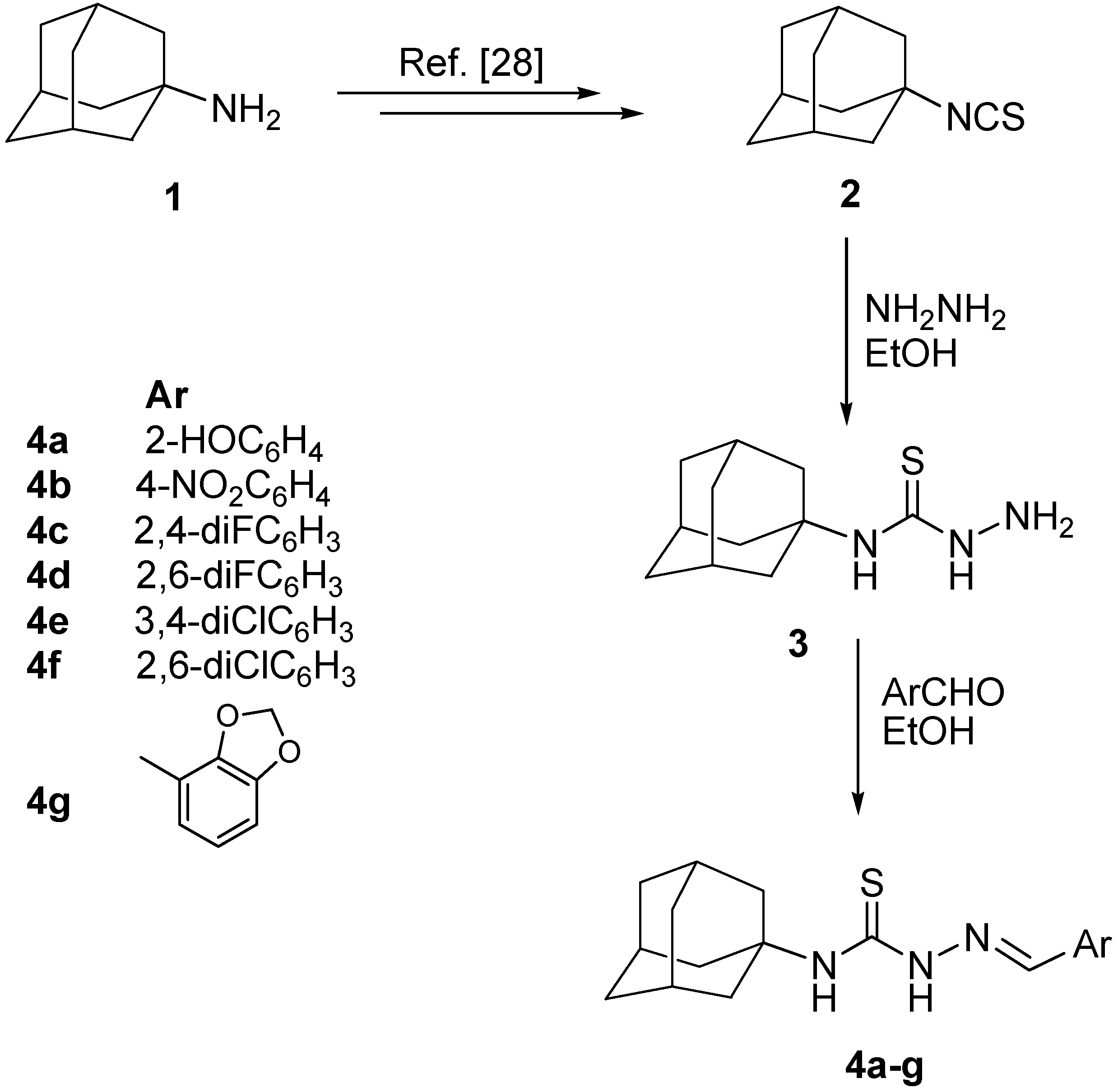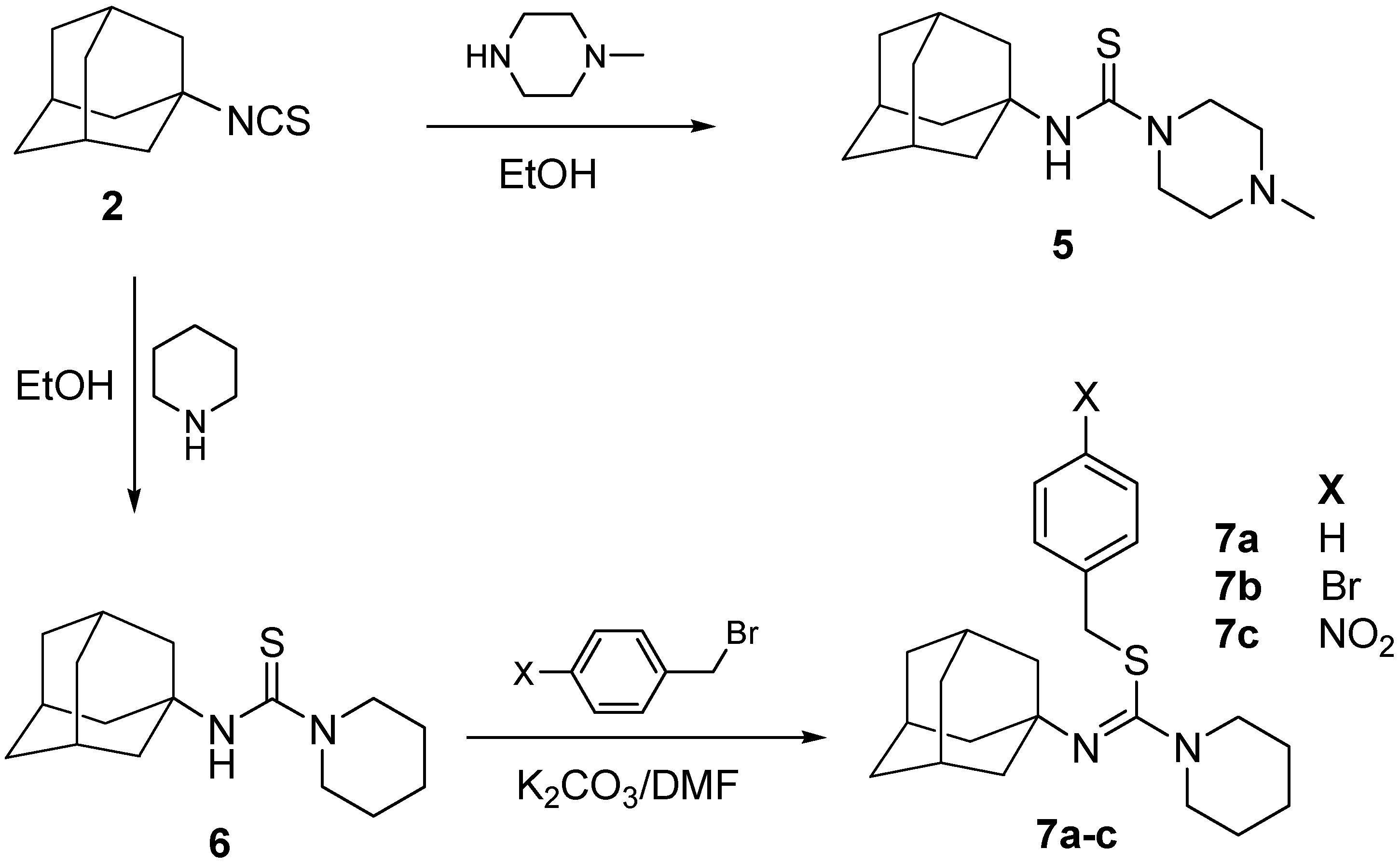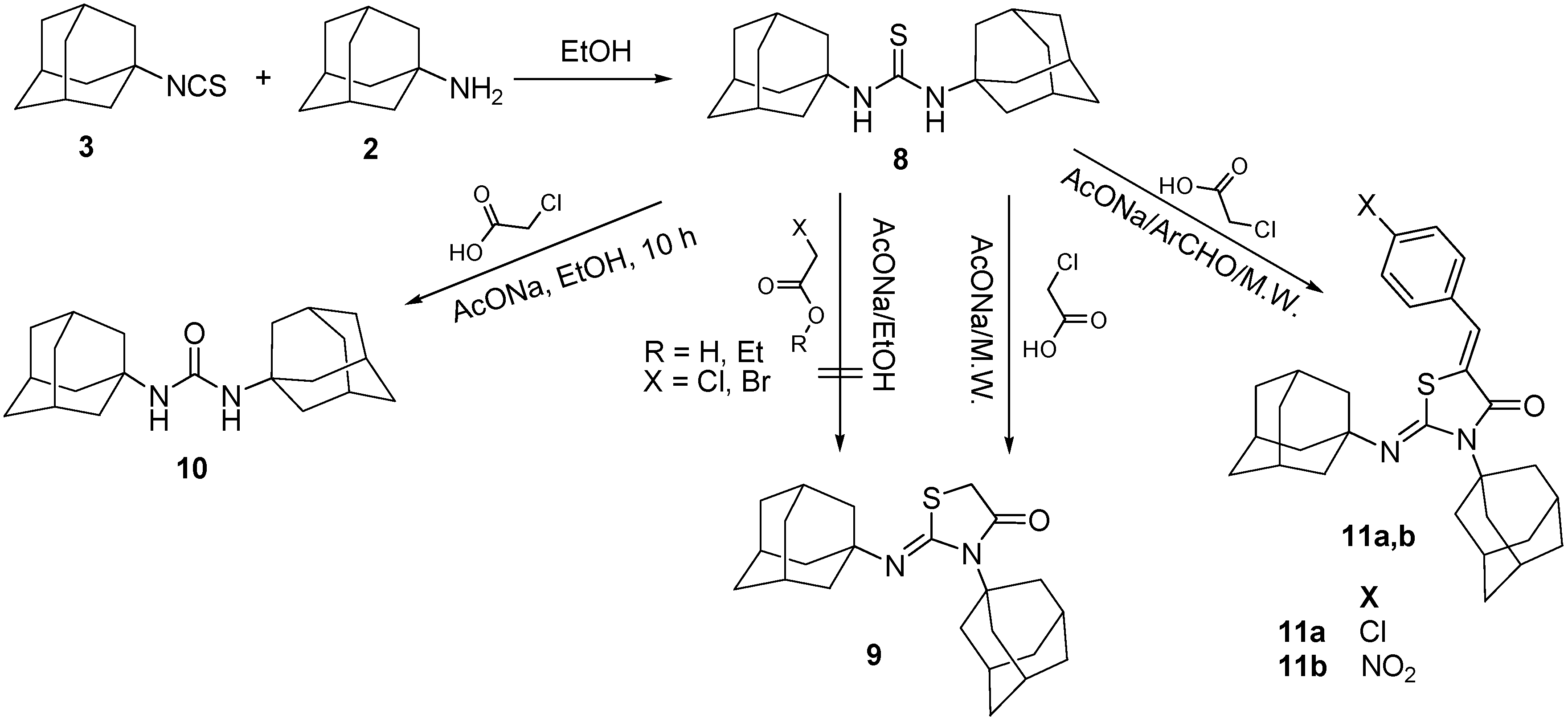Synthesis, Antimicrobial, and Anti-Proliferative Activities of Novel 4-(Adamantan-1-yl)-1-arylidene-3-thiosemicarbazides, 4-Arylmethyl N′-(Adamantan-1-yl)piperidine-1-carbothioimidates, and Related Derivatives
Abstract
1. Introduction
2. Results and Discussion
2.1. Chemical Synthesis
2.2. In Vitro Antimicrobial Activity
2.3. In Vitro Anti-Proliferative Activity
3. Materials and Methods
3.1. General Information
3.2. 4-(Adamantan-1-yl)-3-thiosemicarbazide 3
3.3. 4-(Adamantan-1-yl)-1-arylidene-3-thiosemicarbazides 4a–g
3.4. N-(Adamantan-1-yl)-4-methylpiperazine-1-carbothioamide 5
3.5. 4-Arylmethyl N′-(adamantan-1-yl)piperidine-1-carbothioimidates 7a–c
3.6. 1,3-Bis(adamantan-1-yl)thiourea 8
3.7. 3-(Adamantan-1-yl)-2-(adamantan-1-ylimino)lthiazolidin-4-one 9
3.8. 3-(Adamantan-1-yl)-2-(adamantan-1-ylimino)-5-arylidenethiazolidin-4-ones 11a,b
4. Conclusions
Supplementary Materials
Author Contributions
Funding
Conflicts of Interest
References
- Lamoureux, G.; Artavia, G. Use of the adamantane structure in medicinal chemistry. Curr. Med. Chem. 2010, 17, 2967–2978. [Google Scholar] [CrossRef] [PubMed]
- Wanka, L.; Iqbal, K.; Schreiner, P.R. The lipophilic bullet hits the targets: Medicinal chemistry of adamantane derivatives. Chem. Rev. 2013, 113, 3516–3604. [Google Scholar] [CrossRef] [PubMed]
- Liu, J.; Obando, D.; Liao, V.; Lifa, T.; Codd, R. The many faces of the adamantyl group in drug design. Eur. J. Med. Chem. 2011, 46, 1949–1963. [Google Scholar] [CrossRef] [PubMed]
- Davies, W.L.; Grunnert, R.R.; Haff, R.F.; McGahen, J.W.; Neumeyer, E.M.; Paulshock, M.; Watts, J.C.; Wood, T.R.; Hermann, E.C.; Hoffmann, C.E. Antiviral activity of 1-adamantamine (amantadine). Science 1964, 144, 862–863. [Google Scholar] [CrossRef] [PubMed]
- Wendel, H.A.; Snyder, M.T.; Pell, S. Trial of amantadine in epidemic influenza. Clin. Pharmacol. Therap. 1966, 7, 38–43. [Google Scholar] [CrossRef]
- Wingfield, W.L.; Pollack, D.; Grunert, R.R. Treatment of influenza. The therapeutic efficacy of rimantadine HCl in a naturally occurring influenza A2 Respiratory Illness in man. N. Engl. J. Med. 1969, 281, 579–584. [Google Scholar] [CrossRef]
- Rosenthal, K.S.; Sokol, M.S.; Ingram, R.L.; Subramanian, R.; Fort, R.C. Tromantadine: Inhibitor of early and late events in herpes simplex virus replication. Antimicrob. Agents Chemother. 1982, 22, 1031–1036. [Google Scholar] [CrossRef]
- Balzarini, J.; Orzeszko-Krzesińska, B.; Maurin, J.K.; Orzeszko, A. Synthesis and anti-HIV studies of 2- and 3-adamantyl-substituted thiazolidin-4-ones. Eur. J. Med. Chem. 2009, 44, 303–311. [Google Scholar] [CrossRef]
- Balzarini, J.; Orzeszko, B.; Mauri, J.K.; Orzeszko, A. Synthesis and anti-HIV studies of 2-adamantyl-substituted thiazolidin-4-ones. Eur. J. Med. Chem. 2007, 42, 993–1003. [Google Scholar] [CrossRef]
- El-Emam, A.A.; Al-Deeb, O.A.; Al-Omar, M.A.; Lehmann, J. Synthesis, antimicrobial, and anti-HIV-1 activity of certain 5-(1-adamantyl)-2-substituted thio-1,3,4-oxadiazoles and 5-(1-adamantyl)-3-substituted aminomethyl-1,3,4-oxadiazoline-2-thiones. Bioorg. Med. Chem. 2004, 12, 5107–5113. [Google Scholar] [CrossRef]
- Protopopova, M.; Hanrahan, C.; Nikonenko, B.; Samala, R.; Chen, P.; Gearhart, J.; Einck, L.; Nacy, C.A. Identification of a new antitubercular drug candidate, SQ109, from a combinatorial library of 1,2-ethylenediamines. J. Antimicrob. Chemother. 2005, 56, 968–974. [Google Scholar] [CrossRef] [PubMed]
- Sun, S.Y.; Yue, P.; Chen, X.; Hong, W.K.; Lotan, R. The synthetic retinoid CD437 selectively induces apoptosis in human lung cancer cells while sparing normal human lung epithelial cells. Cancer Res. 2002, 62, 2430–2436. [Google Scholar] [PubMed]
- Britten, C.D.; Garrett-Mayer, E.; Chin, S.H.; Shirai, K.; Ogretmen, B.; Bentz, T.A.; Brisendine, A.; Anderton, K.; Cusack, S.L.; Maines, L.W.; et al. A phase I study of ABC-294640, a first-in-class sphingosine kinase-2 inhibitor, in patients with advanced solid tumors. Clin. Cancer Res. 2017, 23, 4642–4650. [Google Scholar] [CrossRef] [PubMed]
- Zhou, J.; Chen, J.; Yu, H. Targeting sphingosine kinase 2 by ABC294640 inhibits human skin squamous cell carcinoma cell growth. Biochem. Biophys. Res. Commun. 2018, 497, 535–542. [Google Scholar] [CrossRef]
- Omar, K.; Geronikaki, A.; Zoumpoulakis, P.; Camoutsis, C.; Soković, M.; Ćirić, A.; Glamoćlija, J. Novel 4-thiazolidinone derivatives as potential antifungal and antibacterial drugs. Bioorg. Med. Chem. 2010, 18, 426–432. [Google Scholar] [CrossRef]
- Al-Wahaibi, L.H.; Hassan, H.M.; Abo-Kamar, A.M.; Ghabbour, H.A.; El-Emam, A.A. Adamantane-isothiourea hybrid derivatives: Synthesis, characterization, in vitro antimicrobial, and in vivo hypoglycemic activities. Molecules 2017, 22, 710. [Google Scholar] [CrossRef]
- El-Emam, A.A.; Al-Tamimi, A.M.S.; Al-Omar, M.A.; Alrashood, K.A.; Habib, E.E. Synthesis and antimicrobial activity of novel 5-(1-adamantyl)-2-aminomethyl-4-substituted-1,2,4-triazoline-3-thiones. Eur. J. Med. Chem. 2013, 68, 96–102. [Google Scholar] [CrossRef]
- Jia, L.; Tomaszewski, J.E.; Hanrahan, C.; Coward, L.; Noker, P.; Gorman, G.; Nikonenko, B.; Protopopova, M. Pharmacodynamics and pharmacokinetics of SQ109, a new diamine-based antitubercular drug. Br. J. Pharmacol. 2005, 144, 80–87. [Google Scholar] [CrossRef]
- Bogatcheva, E.; Hanrahan, C.; Nikonenko, B.; de los Santos, G.; Reddy, V.; Chen, P.; Barbosa, F.; Einck, L.; Nacy, C.; Protopopova, M. Identification of SQ609 as a lead compound from a library of dipiperidines. Bioorg. Med. Chem. Lett. 2011, 21, 5353–5357. [Google Scholar] [CrossRef]
- De Aquino, T.M.; Liesen, A.P.; da Silva, R.E.A.; Lima, V.T.; Carvalho, C.S.; de Faria, A.R.; de Araujo, J.M.; de Lima, J.G.; Alves, A.J.; de Melo, E.J.T.; et al. Synthesis, anti-Toxoplasma gondii and antimicrobial activities of benzaldehyde 4-phenyl-3-thiosemicarbazones and 2-[(phenymethylene)hydrazono]-4-oxo-3- phenyl-5-thiazolidine acetic acids. Bioorg. Med. Chem. 2008, 16, 446–456. [Google Scholar] [CrossRef]
- Hu, W.-X.; Zhou, W.; Xia, C.-N.; Wen, X. Synthesis and anticancer activity of thiosemicarbazones. Bioorg. Med. Chem. Lett. 2006, 16, 2213–2218. [Google Scholar] [CrossRef] [PubMed]
- Kolocouris, A.; Dimas, K.; Pannecouque, C.; Witvrouw, M.; Foscolos, G.B.; Stamatiou, G.; Fytas, G.; Zoidis, G.; Kolocouris, N.; Andrei, G.; et al. New 2-(1-adamantylcarbonyl) pyridine and 1-acetyladamantane thiosemicarbazones-thiocarbonohydrazones: Cell growth inhibitory, antiviral and antimicrobial activity evaluation. Bioorg. Med. Chem. Lett. 2002, 12, 723–727. [Google Scholar] [CrossRef]
- Koronkiewicz, M.; Romiszewska, A.; Chilmonczyk, Z.; Kazimierczuk, Z. New benzimidazole-derived isothioureas as potential antileukemic agents—Studies in vitro. Med. Chem. 2015, 11, 364–372. [Google Scholar] [CrossRef] [PubMed]
- Nicholson, A.; Perry, J.D.; James, A.L.; Stanforth, S.P.; Carnell, S.; Wilkinson, K.; Anjam Khan, C.M.; De Soyza, A.; Gould, F.K. In vitro activity of S-(3,4-dichlorobenzyl)isothiourea hydrochloride and novel structurally related compounds against multidrug-resistant bacteria, including Pseudomonas aeruginosa and Burkholderia cepacia complex. Int. J. Antimicrob. Agents 2012, 39, 27–32. [Google Scholar] [CrossRef] [PubMed]
- Zhou, H.; Wu, S.; Zhai, S.; Liu, A.; Sun, Y.; Li, R.; Zhang, Y.; Ekins, S.; Swaan, P.W.; Fang, B.; et al. Design, synthesis, cytoselective toxicity, structure-activity relationships, and pharmacophore of thiazolidinone derivatives targeting drug-resistant lung cancer cells. J. Med. Chem. 2008, 51, 1242–1251. [Google Scholar] [CrossRef] [PubMed]
- Vicini, P.; Geronikaki, A.; Anastasia, K.; Incerti, M.; Zani, F. Synthesis and antimicrobial activity of novel 2-thiazolylimino-5-arylidene-4-thiazolidinones. Bioorg. Med. Chem. 2006, 14, 3859–3864. [Google Scholar] [CrossRef]
- Gududuru, V.; Hurh, E.; Dalton, J.T.; Miller, D.D. Synthesis and antiprofilerative activity of 2-arly-4-oxo-thiazolidin-3-yl-amides for prostate cancer. Bioorg. Med. Chem. Lett. 2004, 14, 5289–5293. [Google Scholar] [CrossRef]
- Al-Abdullah, E.S.; Al-Tuwaijri, H.M.; Hassan, H.M.; Al-Alshaikh, M.A.; Habib, E.E.; El-Emam, A.A. Synthesis, antimicrobial and hypoglycemic activities of novel N-(1-adamantyl)carbothioamide derivatives. Molecules 2015, 20, 8125–8143. [Google Scholar] [CrossRef]
- Munch, H.; Hansen, J.S.; Pittelkow, M.; Christensen, J.B.; Boas, U.A. A new efficient synthesis of isothiocyanates from amines using di-tert-butyl dicarbonate. Tetrahedron Lett. 2008, 49, 3117–3119. [Google Scholar] [CrossRef]
- Spilovska, K.; Korabecny, J.; Kral, J.; Horova, A.; Musilek, K.; Soukup, O.; Drtinova, L.; Gazova, Z.; Siposova, K.; Kuca, K. 7-Methoxytacrine-adamantylamine heterodimers as cholinesterase inhibitors in Alzheimer’s disease treatment-synthesis, biological evaluation and molecular modeling studies. Molecules 2013, 18, 2397–2418. [Google Scholar] [CrossRef]
- Richarson, D.; Kalinowski, D.S.; Palanimuthu, D. Adamantane Compounds. WO 2017/214680, 21 December 2017. [Google Scholar]
- Hassan, H.Y.; El- Koussi, N.A.; Farghaly, Z.S. Synthesis and antimicrobial activity of pyridines bearing thiazole and thiazolidine moieties. Chem. Pharm. Bull. 1998, 46, 863–866. [Google Scholar] [CrossRef] [PubMed]
- Danel, K.; Larsen, E.; Pedersen, E.B. Easy synthesis of 5,6-disubstituted acyclouridine derivatives. Synthesis 1995, 1995, 934–936. [Google Scholar] [CrossRef]
- Ballard, E.; Johnson, T.B. Synthesis of derivatives of pyrimidine-5-carboxylic acid. J. Am. Chem. Soc. 1942, 64, 794–798. [Google Scholar] [CrossRef]
- Aldrich, P.E.; Hermann, E.C.; Meier, W.E.; Paulshock, M.; Prichard, W.W.; Snyder, J.A.; Watts, J.C. Antiviral agents. 2. Structure-activity relationships of compounds related to 1-adamantanamine. J. Med. Chem. 1971, 14, 535–543. [Google Scholar] [CrossRef] [PubMed]
- Butov, G.M.; Burmistrov, V.V.; D’yachenko, V.S. Synthesis and properties of symmetrical N,N′-bis(R-adamantan-1-yl)ureas as target-oriented soluble epoxide hydrolase (sEH) inhibitors. Russ. J. Org. Chem. 2017, 53, 977–980. [Google Scholar] [CrossRef]
- Lawrence, N.J.; Armitage, E.S.M.; Greedy, B.; Cook, D.; Ducki, S.; McGown, A.T. The synthesis of indanones related to combretastatin A-4 via microwave-assisted Nazarov cyclization of chalcones. Tetrahedron Lett. 2006, 47, 1637–1640. [Google Scholar] [CrossRef]
- Lu, J.; Li, Y.; Bai, Y.; Tian, M. Green chemistry approaches to the synthesis of 5-arylidenthiobarbituric acids by a condensation reactions between aromatic aldehydes and thiobarbituric acid. Comparison of water, microwave irradiation, and grinding. Heterocycles 2004, 63, 583–589. [Google Scholar] [CrossRef]
- Al-Abdullah, E.S.; Shehata, I.A.; Al-Deeb, O.A.; El-Emam, A.A. Microwave-assisted dehydrosulphurization: An efficient, solvent-free synthesis of 5-(1-adamantyl)-2-arylamino-1,2,4- triazolo[3,4-b][1,3,4]thiadiazoles. Heterocycles 2007, 71, 379–388. [Google Scholar] [CrossRef]
- Woods, G.L.; Washington, J.A. Antibacterial susceptibility tests: Dilution and disk diffusion methods. In Manual of Clinical Microbiology; Murray, P.R., Baron, E.J., Pfaller, M.A., Tenover, F.C., Yolken, R.H., Eds.; American Society of Microbiology: Washington, DC, USA, 1995. [Google Scholar]
- National Committee for Clinical Laboratory Standards. Approved Standard Document M-7A; NCCS: Villanova, PA, USA, 1985. [Google Scholar]
- Mosmann, T. Rapid colorimetric assay for cellular growth and survival: Application to proliferation and cytotoxicity assays. J. Immunol. Methods 1983, 65, 55–63. [Google Scholar] [CrossRef]
- Berridge, M.V.; Tan, A.S. Characterisation of the cellular reduction of 3-(4,5-dimethylthiazol-2yl)-2,5-diphenyltetrazolium bromide (MTT): Subcellular localization, substrate dependence, and involvement of mitochondrial electron transport in MTT reduction. Arch. Biochem. Biophys. 1993, 303, 474–482. [Google Scholar] [CrossRef]
- Stockert, J.C.; Blázquez-Castro, A.; Cañete, M.; Horobin, R.W.; Villanueva, A. MTT assay for cell viability: Intracellular localization of the formazan product is in lipid droplets. Acta Histochem. 2012, 114, 785–796. [Google Scholar] [CrossRef] [PubMed]
- Tacar, O.; Sriamornsak, P.; Dass, C.R. Doxorubicin: An update on anticancer molecular action, toxicity and novel drug delivery systems. J. Pharm. Pharmacol. 2013, 65, 157–170. [Google Scholar] [CrossRef] [PubMed]
Sample Availability: Sample of the compounds are available from the correspondent author. |






| Comp. No. | Clog P | Diameter of Growth Inhibition Zone (mm) a | |||||
|---|---|---|---|---|---|---|---|
| SA | BS | ML | EC | PA | CA | ||
| 4a | 4.605 | 24 (4) b | 27 (2) b | 22 (2) b | 18 (8) b | 17 | 19 (8) b |
| 4b | 4.273 | 16 | 17 | 14 | 11 | - | 11 |
| 4c | 4.816 | 19 (8) b | 22 (4) b | 20 (8) b | 16 | 12 | 12 |
| 4d | 4.816 | 27 (1) b | 29 (0.5) b | 23 (2) b | 22 (2) b | 19 (8) b | 12 |
| 4e | 5.836 | 20 (4) b | 21 (4) b | 18 (32) b | 13 | 11 | - |
| 4f | 5.956 | 29 (0.5) b | 31 (0.5) b | 28 (1) b | 23 (2) b | 18 (16) b | 16 |
| 4g | 4.840 | 22 (2) b | 22 (2) b | 19 (8) b | 14 | 12 | 18 (32) b |
| 5 | 3.793 | 14 | 16 | 11 | - | - | - |
| 7a | 6.984 | 22 (1) b | 26 (1) b | 19 (4) b | 20 (16) b | 17 | 12 |
| 7b | 7.847 | 29 (0.5) b | 32 (0.5) b | 21 (1) b | 22 (2) b | 18 (8) b | 11 |
| 7c | 6.727 | 24 (1) b | 22 (0.5) b | 18 (16) b | 23 (4) b | 18 (32) b | 12 |
| 8 | 5.050 | 11 | 13 | - | - | - | - |
| 9 | 5.499 | - | - | - | - | - | - |
| 11a | 8.445 | 13 | 12 | 12 | - | - | - |
| 11b | 7.475 | 11 | 12 | - | - | - | - |
| Gentamicin sulfate | 27 (1) b | 26 (2) b | 20 (2) b | 22 (0.5) b | 21 (0.5) b | NT | |
| Ampicillin trihydrate | 22 (2) b | 23 (1) b | 20 (2) b | 16 (8) b | 16 (8) b | NT | |
| Clotrimazole | NT | NT | NT | NT | NT | 21 (4) b | |
| Comp. No. | IC50 (µM) a | ||
|---|---|---|---|
| HL-60 | HT-29 | MCF7 | |
| 4a | >100 | 75.60 ± 0.77 | 92.67 ± 2.70 |
| 4d | 32.65 ± 1.52 | 25.46 ± 1.22 | 22.40 ± 1.20 |
| 4f | 24.98 ± 2.02 | 47.50 ± 1.27 | 32.75 ± 2.90 |
| 4g | 24.24 ± 1.33 | 18.99 ± 1.02 | 24.02 ± 0.88 |
| 7a | 6.62 ± 0.52 | 4.25 ± 0.08 | 1.55 ± 0.04 |
| 7b | 5.30 ± 0.99 | 3.67 ± 1.02 | 0.95 ± 0.09 |
| 7c | 8.43 ± 1.01 | 2.68 ± 0.32 | 0.46 ± 0.33 |
| 9 | >100 | >100 | >100 |
| 11a | >100 | >100 | >100 |
| Doxorubicin | 1.05 ± 0.12 | 0.32 ± 0.02 | 0.11 ± 0.10 |
© 2019 by the authors. Licensee MDPI, Basel, Switzerland. This article is an open access article distributed under the terms and conditions of the Creative Commons Attribution (CC BY) license (http://creativecommons.org/licenses/by/4.0/).
Share and Cite
Al-Mutairi, A.A.; Al-Alshaikh, M.A.; Al-Omary, F.A.M.; Hassan, H.M.; El-Mahdy, A.M.; El-Emam, A.A. Synthesis, Antimicrobial, and Anti-Proliferative Activities of Novel 4-(Adamantan-1-yl)-1-arylidene-3-thiosemicarbazides, 4-Arylmethyl N′-(Adamantan-1-yl)piperidine-1-carbothioimidates, and Related Derivatives. Molecules 2019, 24, 4308. https://doi.org/10.3390/molecules24234308
Al-Mutairi AA, Al-Alshaikh MA, Al-Omary FAM, Hassan HM, El-Mahdy AM, El-Emam AA. Synthesis, Antimicrobial, and Anti-Proliferative Activities of Novel 4-(Adamantan-1-yl)-1-arylidene-3-thiosemicarbazides, 4-Arylmethyl N′-(Adamantan-1-yl)piperidine-1-carbothioimidates, and Related Derivatives. Molecules. 2019; 24(23):4308. https://doi.org/10.3390/molecules24234308
Chicago/Turabian StyleAl-Mutairi, Aamal A., Monirah A. Al-Alshaikh, Fatmah A. M. Al-Omary, Hanan M. Hassan, Areej M. El-Mahdy, and Ali A. El-Emam. 2019. "Synthesis, Antimicrobial, and Anti-Proliferative Activities of Novel 4-(Adamantan-1-yl)-1-arylidene-3-thiosemicarbazides, 4-Arylmethyl N′-(Adamantan-1-yl)piperidine-1-carbothioimidates, and Related Derivatives" Molecules 24, no. 23: 4308. https://doi.org/10.3390/molecules24234308
APA StyleAl-Mutairi, A. A., Al-Alshaikh, M. A., Al-Omary, F. A. M., Hassan, H. M., El-Mahdy, A. M., & El-Emam, A. A. (2019). Synthesis, Antimicrobial, and Anti-Proliferative Activities of Novel 4-(Adamantan-1-yl)-1-arylidene-3-thiosemicarbazides, 4-Arylmethyl N′-(Adamantan-1-yl)piperidine-1-carbothioimidates, and Related Derivatives. Molecules, 24(23), 4308. https://doi.org/10.3390/molecules24234308





